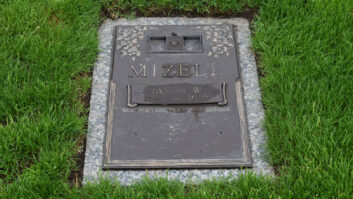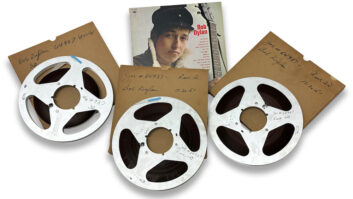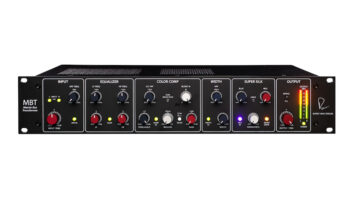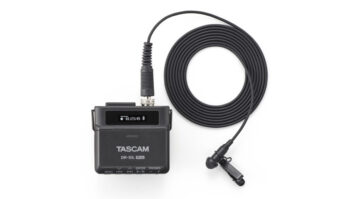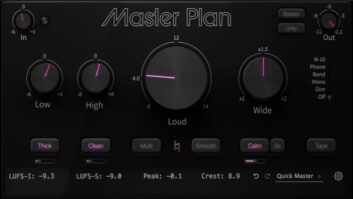For years, Fostex has delivered portable timecode DAT decks designed for the nerve-wracking world of location recording, a gig that demands reliability, portability and minimal battery consumption. Fostex’s next generation is the PD-6, a 6-track portable deck that records to removable 8CM DVD-RAM discs.
The companion to the PD-6 is the DV40 ($5,995 MSRP), a rackmount 4-track version. (A 6-track playback option for the DV40, called the 5050 option, is in the works for full compatibility with the PD-6.) With sampling rates up to 192 kHz and 24-bit resolution, the DV40 records audio either as a Broadcast Wave File (BWF) or as Sound Designer (SDII) file for compatibility with PC- or Mac-based DAWs.
A truly pro example of dedicated hardware, the DV40’s front panel has familiar knobs and switches: frame rate, clock, timecode generator, sample rates, pull-up/down, record level, monitor switching and level. Also standard are keyboard and mouse ports (an optional VGA card allows video access), local/remote switching via an RS-422 or network port, Record mode (mono/stereo/multitrack selection) and analog/digital source switching.
Like the early CD drives for computers, the DVD-RAM drive requires a caddy or carrier with an integral disc. You can use a disc without the case for playback. Not all DVD drives accept DVD-RAM, although the DV40’s drive accepts bare-naked CDs.
The DV40 offers two DVD-RAM formatting options: Tape mode is like pre-striping a tape (simultaneously recording silence while formatting). As such, the user must choose — and is locked into — the sample rate, bit depth and audio format (BWF or SDII). Tape mode adds an extra level of data insurance, allowing the DV40 to tolerate a power interruption while recording without losing the track (up to that point) or its neighbors. Normal mode allows multiple recording options on-the-fly.
The DV40 is a young, but expanding, product. Fostex plans to offer additional features such as a built-in hard drive, an optional file format (in addition to BWF and SDII) and two more tracks, substituting the optional VGA card for the extra audio playback capacity. DV40 software updates (currently at Version 1.3) are available online and must be burned to CD for transfer, a painless process.
The manual is thorough but not clear, and is in serious need of a rewrite. While the machine is fairly intuitive, you’ll definitely want to learn on your own and take notes.
ON THE ROAD
I took the DV40 on location to an unfinished facility to record a jazz trio. Pro Tools|HD served as the multitrack; seven tracks for seven mics were either mixed live or during playback via a Yamaha DM2000 and sent as a stereo pair to the DV40 — a completely digital signal path captured at 88.2 kHz/24 bit. The other pair of tracks were fed by one of two Audio-Technica stereo shotgun mics (from the balcony) through a Great River preamp directly into the DV40’s analog inputs.
The session is described in more detail at www.tangible-technology.com, where you’ll also find a respectable MP3 to check out for yourself. Sennheiser HD600 headphones were used to monitor the DV40 while on location. Speaking of which, the DV40 has three monitoring options: all four tracks summed to mono, or either pair of tracks in stereo. A Grace 901 headphone amp was also used, taking advantage of both its digital and analog inputs to monitor each pair of tracks.
MANHATTAN XFER
Once back at home base, the DV40 was interfaced to an Alesis MasterLink via the AES port for real-time transfer of the main stereo pair at full resolution. Because I didn’t have a multichannel AES interface, I tried to download the four channels via the network port using TCP/IP protocol, a standard Cat-5 networking cable, a hub and Cute FTP (a simple file-transfer program). No dice. (Note: Fostex says it is now delivering an improved ethernet card for better data transfer.) For round two, I enlisted the help of my friend Dave Meyers at Overkill Audio, this time using the recommended shareware FTP software and a “crossover” cable, one designed for direct computer-to-computer connection sans hub. Once communications were established, we tried again to use a standard cable and hub, but no success. The manual includes a step-by-step guide to walk users through the complexity of the FTP interface.
Ultimately, the DV40 should effortlessly connect to any network, and perhaps it will by the time you read this. Meanwhile, the networking feature supports multiple users and passwords, plus all the typical TCP/IP tweaks (IP address, subnet mask and gateway). It would be cool if the DV40 also allowed dynamic IP address assignment from a gateway or address server to eliminate potential conflicts.
FILE TRANSFER
The four channels are embedded into a single file that will appear in the FTP window. Once transferred to computer, I used Syntrillium’s Cool Edit Pro (CEP) to open them. My hardware did not support the higher resolution, so a CEP plug-in utility down-converted each of the four tracks to 44.1 kHz/32 bit to make them playable on a Soundscape Mixtreme card. At the moment, the transfer process is more like rush hour than the Indy 500, but the DV40 otherwise works reliably and sounds good.
While the network feature is cool, until the transfer rate is upgraded (to 7x faster than real time), I suspect most users will either transfer via AES or have a workstation outfitted with a DVD-RAM drive. The disc formatting is readable by both Windows and OS 9.1 or later Macs. For our test, a 6-minute, 600MB file transferred in just over an hour.
I connected a keyboard and mouse, hoping to be spared the “spin-shuttle-wheel-to-select-alphanumeric-characters” routine. So far, the keyboard is mostly used for hot keys. (An overlay would be nice.) F1 brings up the Track Rename feature using the arrow keys instead of the machine’s shuttle knob. Future software revisions will include file naming via the keyboard’s QWERTY section.
There were moments when I felt I needed more feedback from the DV40, such as a confirmation or warning beeper. The DV40 executes some commands instantaneously, but when skipping from track to track, it takes a moment. Pressing Play before it reaches its destination yields nothing; it doesn’t “stack” the Play command.
Some things I would like to see on the DV40 are a hard drive (Fostex is working on this), the beeper and an Auto Play feature. The 4.7-gig DVD-RAM capacity is fine for traditional sample rate and bit depths, but a full-length classical or jazz recording (4-channel/88.2kHz/24-bit) consumes about 100 MB/minute for about 47 minutes of recording time. I have a feeling some audiophile recordists are going to jump on this box big time for its high resolution; a hard drive would eliminate the time obstacles imposed by a single DVD-RAM disc and its 2G + 2G + .7G default partitions. It’s possible to use 9.4-gig discs to increase total recording time, and an upcoming software update will increase the partition size to 4G.
THE PAYOFF
While still young in its development, there were no failures or glitches in the DV40, just features I’d like to see implemented. The DV40 is professionally outfitted and generally intuitive after you spend time poking around the menus, with well-appointed front/rear panels. As “just” a high-resolution recorder, the DV40 is impressive. As a replacement for the timecode DAT format along with a compatible portable, the pair will be a knockout.
Fostex America, 15431 Blackburn Ave., Norwalk, CA 90650; 562/921-1112; www.fostexdvd.net.

